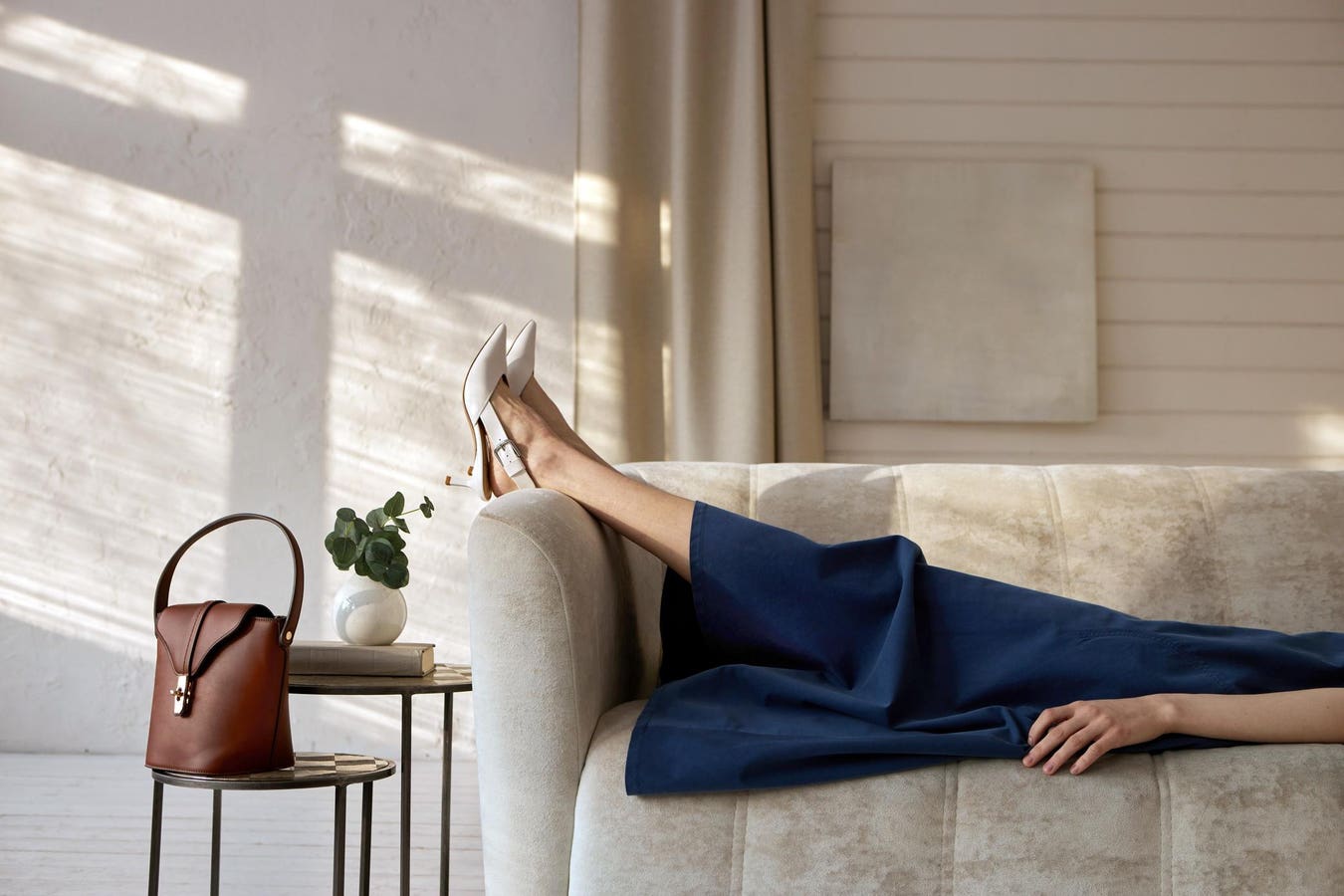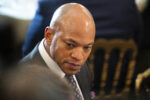Side view of crop anonymous female wearing blue dress and high heels while lying on sofa near coffee … More
The personal luxury goods market faces a decline of up to 5% this year as consumer enthusiasm wanes, according to the latest projections from Bain and Company in association with Altagamma. Not since the 2008-2009 financial crisis has the luxury market experienced such a significant contraction, except for the 2020 Covid pandemic.
Besides the obvious flashpoints creating uncertainty in the market, including rising geopolitical tensions, currency fluctuations and volatile economic pressures, luxury consumers are disillusioned by the industry’s offerings, particularly after post-pandemic price increases threw a monkey wrench into brands’ traditional price-value relationship.
“There’s a sense of emotional detachment, even among the wealthy, who can’t explain why the same bag that cost $1,200 before now costs $2,000 – prices are too high for such a low level of creativity,” Bain’s senior partner Federica Levato shared with me. “The disillusionment and detachment we talk about is particularly noted among younger consumers.”
Bain’s Macro Overview
Rising luxury consumer detachment was reflected last year, as the luxury market declined 1% at current exchange rates to $418 billion (€364 billion) – or remained flat at constant rates. Yet, most telling was that the luxury market lost some 50 million customers over the last two years. Today, the estimated number of luxury consumers worldwide is approximately 353 million, down from 400 million in 2022.
“This is true alienation, meaning many people are just not buying anymore,” she observed, adding that engagement with luxury brands across all demographics, not just the younger aspirational cohort, has declined since 2022.
Brand-related searches and engagement rates are down more than 40% and social media follower growth has plummeted by 90% – “largely due to price fatigue and stagnant creativity.”
Creative Churn
For an industry that thrives on artistic creativity, the growing churn in luxury brand senior executives and creative directors is taking its toll. Consumers may not be aware of what’s going on behind the curtain, but they see it in the stores and the brands ultimately feel it on their top and bottom line.
“While companies are waiting for a new creative director to introduce a new collection, it can take nine months to a year for the transition – like giving birth to a baby,” Levato explained. “Consumers may not know about the shifts, but they see it when no new products arrive and the brands are totally silent during the transition.”
And she added, “Then there’s also a 50% probability that the new collection doesn’t work, as has been the case for some brands in the recent past.”
Profit Pressure
All this is sinking to luxury brands’ bottom line. Bain notes that since 2021, margins (defined by earnings before interest and taxes) have either stagnated or declined, even among top industry performers, and margins are expected to erode further in 2025.
“All the macroeconomic uncertainties, tariffs, lower traffic, fewer new products – over 70% of luxury brands are pulling back volume from multi-brand retail platforms – have an impact on the topline, but have a more than proportional impact on the bottom line and on the EBIT,” Levato said.
“The message is to some extent is positive because brands are not hitting the brakes on investments in technology, marketing, clienteling and stores, but they still must absorb the costs,” she continued, adding further price increases are probably off the table in the current environment.
Global Luxury Reset
Saying the luxury market faces “far-reaching disruptions,” the Bain report also stresses the industry’s proven resiliency, yet Levato stresses industry players can’t rest on their laurels.
“As the industry faces an increasingly complex global landscape, luxury brands are entering a pivotal new chapter – one that demands sharper focus, greater cultural relevance, and growth rooted in purpose.
“At the heart of this transformation is a redefinition of value and meaning that resonates across all generations – with those shaping luxury today, and those who will define it tomorrow,” she observed.
U.S. Luxury Consumers On Hold
Because the U.S. is the world’s richest market – last year 1,000 new millionaires were minted here each day, totaling nearly 400,000, and more than half of all new millionaires globally – and the largest personal luxury market by far – the Americas totaled about $115 billion last year with the lion’s share in the U.S., compared to $51 billion in Mainland China – what happens here will have a profound impact on the global personal luxury market overall.
According to the Affluent Consumer Research Company’s May luxury tracking survey, luxury consumer fatigue is measurable. Specifically, 52% of the 300+ affluent Americans with incomes of $250,000 and above reported being disappointed with luxury options, and 46% were unable to justify new purchases.
But most telling is that among those affluents who tend to opt for the luxury option most often, 55% said they’re bidding their time, and the same 55% share signaled that the available options simply do not move them.
“Purchase hesitation isn’t one-size-fits-all,” observed ACRC’s founder and CEO Chandler Mount. “At the top of the market, it’s not about affordability – it’s about emotional resonance. They’re bidding their time, a signal of flexibility, not resistance. Yet, there remains a lack of enthusiasm and emotional draw for affluent consumers.” Note: I am professionally affiliated with ACRC.
While Americans wait for luxury goods brands to present more compelling options, Bain reports that the luxury experiences market, including hospitality, fine dining, cruising and private jets, is “flourishing,” as consumers prioritize meaningful experiences over goods, particularly among older consumers, where wealth tends to accumulate.
Personal Transformation Is The Goal, Not More Stuff
At its core, luxury is a cultural construct rooted in personal meaning, social status, and an expression of self-worth. While owning an abundance of luxury goods can confer some of those advantages, increasingly affluent and high-net-worth individuals are turning luxury expression inward toward personal growth and well-being.
This cultural shift in consumer consciousness has profound implications for the goods side of the luxury market. “This isn’t a trend – it’s a complete reconstruction of how success is defined by the world’s most affluent and influential consumers,” said Mark Miller, chief strategy officer at Publicis Groupe’s Team One agency. “It’s a shift from building high-net-worth to pursuing high-life-worth.”
He was speaking about Team One’s latest study entitled “Worth Beyond Wealth,” based upon research among its exclusive Global Affluent Collective. The collective represents the top 10% of global earnings across 22 countries and totals some 4,200 consumers aged 25 and above.
“The most provocative finding is how they’ve moved beyond asking ‘What do I own?’ to ‘Who am I becoming?’ This transformation demands an entirely new approach from premium brands,” he continued.
Emerging Values
Findings that popped in the study, which combined both qualitative and quantitative research, include:
- Prioritizing emotional fulfillment and human connection through key life moments defined by meaningful connections (89%) and relationships that elevate their lives (90%).
- Pursuit of growth and discovery with continuous learning their ultimate luxury (95%) and 75% defining personal growth as life’s most significant moments.
- Belief that status is earned through being knowledgeable and respected rather than through possessions (88%).
This shift toward pursuit of high-life-worth through meaningful experiences requires luxury goods brands adapt to a new “return on worth” price-value framework. Miller described this as a selective abundance approach, where people with means will spend abundantly on things that have special worth and save abundantly, i.e. trade down, in purchases that are substitutable or replaceable.
“There’s a strong need in this world of selective abundance for luxury goods brands to not just make things that are functionally excellent – consumers will know the difference – but to offer a value proposition that goes above and beyond the functional things they make,” he explained, stressing the need for greater high-life-worth storytelling, rather than relying on product features, benefits, brand heritage, design and quality.
“Luxury is no longer only about having exceptional things – it’s about integrating excellence with impact. The best premium brands won’t just sell luxury – they’ll help architect high-worth lives,” shared Tahini Candelaria, Team One’s director of cultural anthropology.
Miller added, “Luxury isn’t just about possessions anymore. It’s about acquiring the learning and relationships to become a more evolved version of who I aspire to be over time.”
Value Beyond Money
While the Bain study acknowledges some of this – “Across generations, drivers linked with self-reward, status, personal identity and the celebration of achievements will continue to drive engagement, reinforcing and building the lasting relevance of luxury with the consumers’ lives,” Claudia D’Arpizio said in a statement – Team One’s perspective pushes the concepts of luxury as self-reward, status, personal identity and celebrating achievements further toward value beyond what money can buy.
These insights require luxury goods brands to reframe their value proposition above the price-value relationship toward a return on worth. “The notion of worth is becoming far more dominant in how affluent consumers express themselves. Luxury consumption is becoming more conscious, purposeful, meaningful and impactful with a long-tail orientation that looks to the future, not to the past,” Miller concluded.










